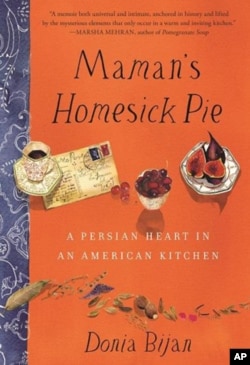Donia Bijan is an Iranian-American chef who fled Iran with her family during the 1979 revolution. After settling in the United States, Bijan's mother experimented with American cooking but always incorporated familiar Persian flavors, recreating a sense of home for her family. She passed those recipes to her daughter.
Bijan spent her first 16 years in Iran.
“My parents had a hospital in Tehran," she recalls. "I grew up in the top floor of the hospital. It had a beautiful garden. We even had planted vegetables, and I watched my parents run this hospital like you run a large family.”
Her mother ran the kitchen, and that’s where Donia took her first cooking lesson.
“My mother planned the menus for the patients," she says. "I was always welcome in the kitchen."
When the family had to leave Iran, they headed to San Francisco.
“And again, I watched her in the kitchen in America transform and try to learn and tune in to the flavors of her new country through their food and by cooking. ”
Food helped Bijan’s mother connect with neighbors. But her Persian recipes on the family dinner table helped heal their homesick hearts as well. Food became an expression of belonging and later, for Bijan, a career.
With her mother’s encouragement, Bijan pursued her dreams. After studying at Le Cordon Bleu in Paris, she returned to San Francisco and started her own French restaurant. But a few years ago, she began to rediscover Persian cuisine.
“When my mother died in 2004, I found these recipes and I very much felt that she had left those for me to find and that they carried her story," she says. "But it took me over a year to really understand what to do with it.”
Bijan decided to compile the recipes in a cookbook. She calls it a “food memoir.”
“I realized that recipes are so dull, if they are just instructions. And you can convey so much with a recipe if it is tied in with a story."
Bijan's book, "Maman’s Homesick Pie: A Persian Heart in An American Kitchen," contains 30 recipes. They include Saffron Yogurt Rice with Chicken and Eggplant, Braised Chicken with Persian Plums, and Orange Cardamom cookies. All are delivered with stories.
“When I was talking about spending our summers by the Caspian Sea, it was natural for me to include fava bean omelet because I remember eating it by the seaside with all my relatives," Bijan says.
The book includes some of her own recipes, too.
“When I talk about the ratatouille that I made in Paris," she says, "it was also a natural transition from describing how nervous I was that my father was going to come and visit me in Paris, and I wanted to show off really what I had learned, and I bungled the whole thing.”
Bijan is a regular customer of the date farmer who comes weekly to the farmers’ market in San Francisco. She uses his dates to make Cinnamon Date Bars.
“I remember that there was a similar cookie that my mother would buy for me," she says. "She was a member of parliament and the district was in the center of Iran where they specialize in these date cookies. She would go away to visit her district and I would miss her so much. And she would come back, slowly take this box out of her purse and hand it to me. Everything was forgiven in that moment. Her absence was forgiven.”
Bijan, who hopes readers will try some of the recipes, says Persian dishes are not as difficult to make as they might seem. All it takes is patience and practice.










